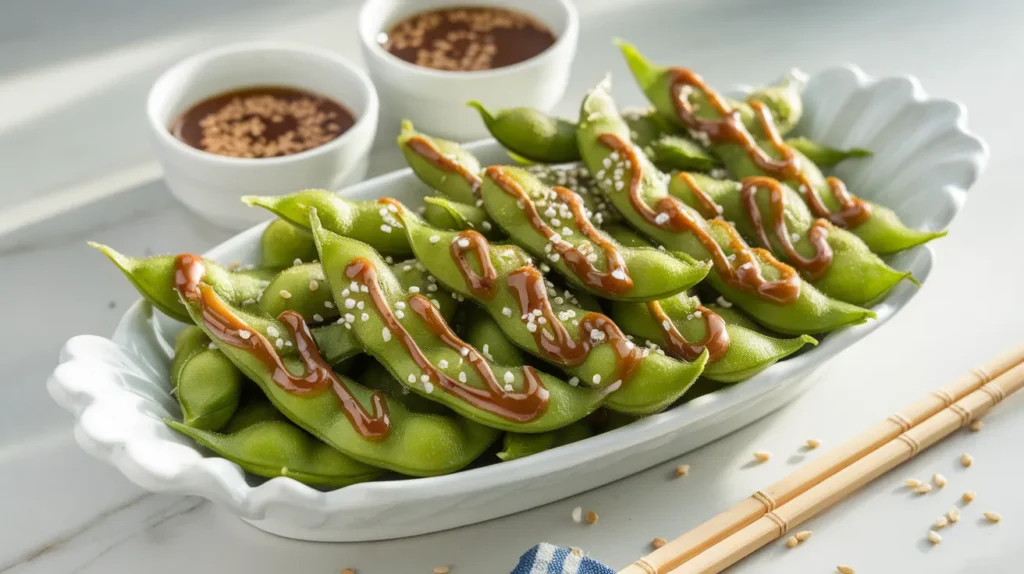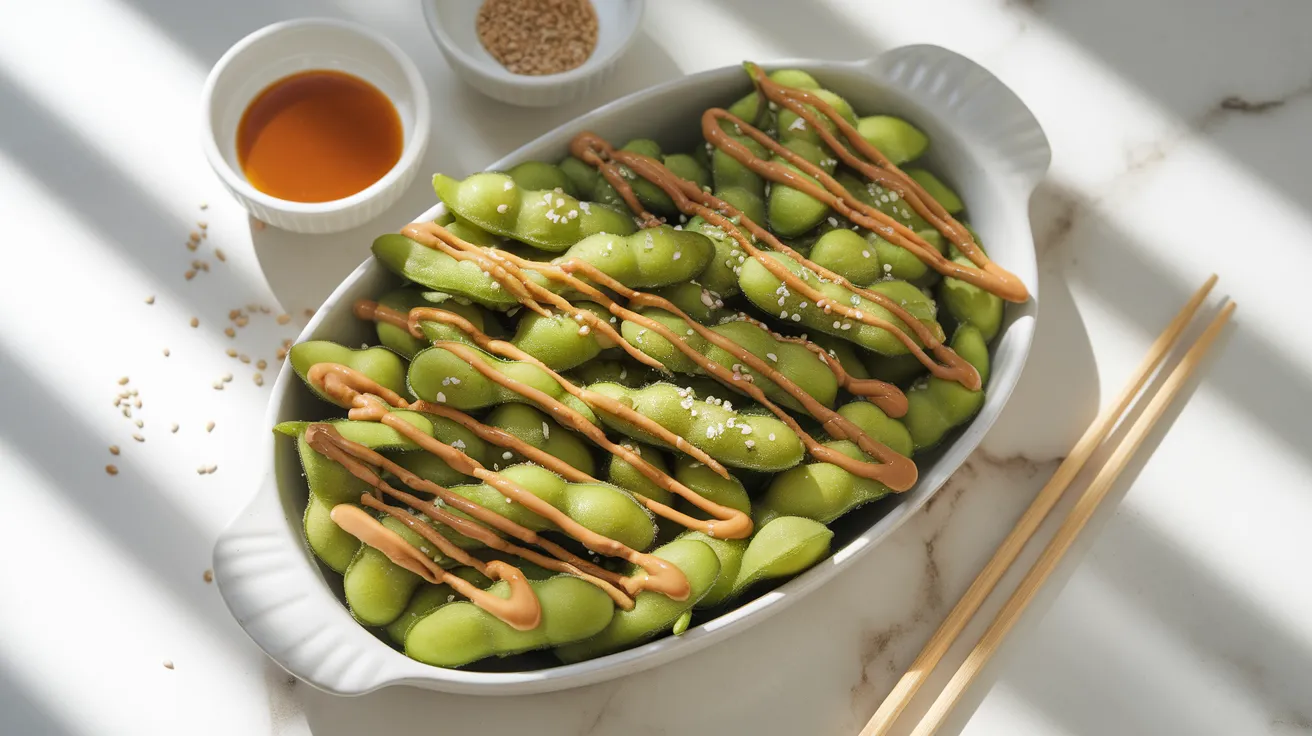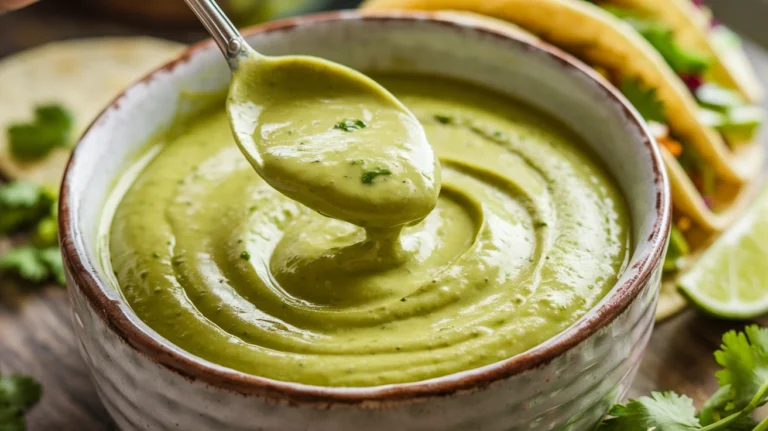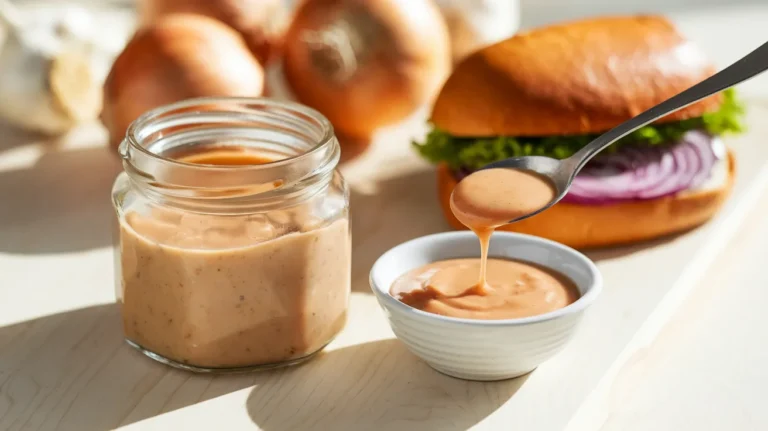This foolproof sauce for edamame recipe creates a restaurant-quality dipping sauce that transforms simple steamed beans into an addictive appetizer. With detailed step-by-step instructions, even complete beginners can master this flavorful sauce for edamame that serves four people perfectly.
SERVES: 4 | PREP: 15 MIN | COOK: 10 MIN | TOTAL: 25 MIN
Ingredients
For the Sauce for Edamame
| Ingredient | Amount |
|---|---|
| Soy sauce (low sodium) | 3 tablespoons |
| Rice vinegar | 2 tablespoons |
| Sesame oil | 1 tablespoon |
| Honey | 2 teaspoons |
| Fresh ginger, grated | 1 teaspoon |
| Garlic, minced | 2 cloves |
| Red pepper flakes | 1/4 teaspoon |
| Sesame seeds | 1 tablespoon |
For the Edamame
| Ingredient | Amount |
|---|---|
| Frozen edamame in pods | 1 pound |
| Coarse sea salt | 2 tablespoons |
Complete Step-by-Step Instructions for Sauce for Edamame
Phase 1: Setting Up Your Workspace (3 minutes)
- Clear and clean your countertop completely. Wipe down all surfaces with a damp cloth. Having a clean workspace prevents contamination and makes cooking more enjoyable. Set out all your ingredients in the order you’ll use them – this technique is called “mise en place” and professional chefs swear by it.
- Gather all your measuring tools before starting. You’ll need measuring spoons (1 tablespoon, 1 teaspoon, 1/4 teaspoon), measuring cups, and a small whisk. Having everything ready prevents you from scrambling mid-recipe, which can lead to mistakes or burnt ingredients.
- Fill a large pot (at least 4 quarts) with water and place it on the stove. Don’t turn the heat on yet – we’ll do that in Phase 4. Use the largest pot you have because edamame needs room to move around while cooking. If your pot is too small, the beans will cook unevenly.
Phase 2: Preparing Fresh Ingredients (5 minutes)
- Peel a 2-inch piece of fresh ginger using a spoon. Here’s a beginner tip: the edge of a spoon scrapes off ginger skin more efficiently than a knife and wastes less ginger. Hold the ginger firmly and scrape away from your body in short, firm strokes until all the brown skin is removed.
- Grate the peeled ginger using the smallest holes on your box grater. Work slowly and watch your fingers – stop grating when you get close to your fingertips. You should have about 1 teaspoon of grated ginger. If you don’t have a grater, mince it as finely as possible with a sharp knife.
- Peel 2 garlic cloves by placing them under the flat side of your knife blade. Press down firmly with your palm – you’ll hear a slight crack. The papery skin will loosen and peel off easily. This technique also starts breaking down the garlic, making it easier to mince.
- Mince the garlic into tiny, uniform pieces. Rock your knife back and forth over the garlic, keeping the tip on the cutting board. The pieces should be no larger than rice grains. Properly minced garlic distributes flavor evenly and won’t create strong, bitter bites in your sauce for edamame.
Phase 3: Toasting Sesame Seeds (3 minutes)
- Place a small, dry skillet over medium heat. No oil needed – this is called “dry toasting.” Let the pan heat for about 30 seconds. To test if it’s ready, flick a drop of water into the pan – it should sizzle and evaporate immediately.
- Add 1 tablespoon of sesame seeds to the hot pan. Spread them in a single layer using a wooden spoon. Don’t leave them unattended – sesame seeds go from perfectly toasted to burnt in seconds.
- Stir the seeds constantly for 1-2 minutes. They’re done when they turn light golden brown and smell nutty. You’ll hear them start to pop slightly – that’s your cue they’re nearly ready. Remove the pan from heat immediately to prevent overcooking.
- Transfer toasted seeds to a small plate to cool. Leaving them in the hot pan will continue cooking them. Set aside half for the sauce and half for garnish.
Phase 4: Making Your Sauce for Edamame Base (4 minutes)
- In a medium mixing bowl, combine soy sauce, rice vinegar, and honey. Use a bowl with high sides to prevent splashing when whisking. Start with the soy sauce, then add vinegar, then honey. This order helps the honey dissolve more easily.
- Whisk the mixture vigorously for 30 seconds. The honey should completely disappear into the liquid. If you see honey clumps, keep whisking. A smooth base ensures your final sauce for edamame won’t have sticky spots.
- Add the minced garlic and grated ginger to the bowl. These aromatics need time to infuse the sauce, so add them now rather than at the end. Stir them in thoroughly with your whisk.
- Slowly drizzle in the sesame oil while whisking continuously. Pour it in a thin stream, like you’re drawing a line across the bowl. This creates an emulsion – a fancy word for mixing oil and water-based ingredients that normally separate.
- Add 1/4 teaspoon red pepper flakes and half the toasted sesame seeds. Start with less red pepper if you’re sensitive to heat – you can always add more later. The sesame seeds add texture and nutty flavor to complement the edamame.
Phase 5: Cooking Perfect Edamame (8 minutes)
- Turn the heat under your pot of water to high and cover with a lid. The lid traps heat and helps the water boil faster. Large bubbles breaking the surface mean it’s at a rolling boil – exactly what we need.
- Add 1 tablespoon of salt to the boiling water. The water should taste like mild seawater. This seasons the edamame beans inside their pods, creating better flavor than salting only the outside.
- Carefully add the entire pound of frozen edamame to the boiling water. Don’t defrost them first – frozen edamame actually cook more evenly. Use a long spoon to stir them gently and prevent sticking.
- Set a timer for exactly 4 minutes. Overcooking makes edamame mushy and unpleasant. The pods should turn bright green and the beans inside should be tender but still have a slight bite.
- While edamame cook, fill a large bowl with ice water. This “ice bath” stops the cooking process immediately and keeps the edamame bright green. Use equal parts ice and cold water.
- Test doneness by carefully removing one pod with tongs. Squeeze gently – the bean should pop out easily. If it’s difficult to remove, cook 30 seconds longer.
- Drain edamame in a colander immediately when timer goes off. Work quickly to prevent overcooking. Shake the colander to remove excess water.
- Plunge the hot edamame into the ice water bath for 30 seconds. This “shocking” technique stops the cooking process and locks in the vibrant green color and perfect texture.
Phase 6: Final Assembly and Serving (2 minutes)
- Remove edamame from ice water and pat completely dry with paper towels. Wet pods won’t hold salt and will dilute your beautiful sauce for edamame. Take time to dry them thoroughly.
- Sprinkle the remaining tablespoon of coarse salt over the edamame pods. Use coarse salt rather than table salt – it clings better and provides pleasant texture bursts. Toss with your hands to distribute evenly.
- Arrange edamame on your prettiest serving platter. Create height by mounding them slightly in the center rather than spreading them flat. This looks more appealing and professional.
- Give your sauce for edamame a final stir and taste. Adjust seasoning now if needed – add more honey for sweetness, rice vinegar for tang, or red pepper flakes for heat.
- Drizzle half the sauce over the arranged edamame. Pour it artfully in zigzag patterns rather than dumping it all in one spot. Save the remaining sauce in a small bowl for extra dipping.
- Garnish with reserved toasted sesame seeds. Sprinkle them over the entire platter for visual appeal and extra crunch. Provide small bowls for discarded pods and serve immediately while warm.
Chef’s Notes for Perfect Sauce for Edamame
• Temperature matters: Serve this sauce for edamame at room temperature while the edamame are still warm. The temperature contrast enhances both flavors.
• Make it ahead: Your sauce for edamame actually improves after 30 minutes as flavors meld. Store covered at room temperature for up to 2 hours.
• Spice control: Start with half the red pepper flakes in this sauce for edamame recipe. You can always add more, but you can’t take heat away.
• Fresh ingredient impact: Fresh ginger and garlic create a much brighter sauce for edamame than dried alternatives. It’s worth the extra prep time.
Nutrition Information (Per Serving)
- Calories: 145
- Protein: 8g
- Carbohydrates: 12g
- Fat: 6g
- Fiber: 4g
Creative Variations of Sauce for Edamame
Spicy Sriracha Sauce for Edamame
Replace red pepper flakes with 1 teaspoon sriracha for a garlicky kick that pairs perfectly with the nutty sesame flavors. This bold variation reminds me of the exciting flavors in this sauce for dipping chicken.
Citrus Ginger Sauce for Edamame
Add 1 tablespoon fresh lime juice and 1 teaspoon lime zest for a bright, tropical spin on the classic recipe.
Sweet Miso Sauce for Edamame
Substitute 1 tablespoon white miso paste for half the soy sauce to create a deeper, more complex umami flavor profile.
Thai-Inspired Sauce for Edamame
Include 1 teaspoon fish sauce and 1/2 teaspoon brown sugar for a Southeast Asian twist that’s similar to the complex flavors in this sauce for egg rolls.
Storage & Reheating Your Sauce for Edamame
Sauce Storage: Keep your sauce for edamame covered in the refrigerator for up to 7 days. The flavors actually improve over time.
Edamame Storage: Store cooked edamame separately in the refrigerator for 3-4 days. Never store them mixed with the sauce – they’ll become soggy.
Reheating: Steam leftover edamame for 2-3 minutes or microwave for 30 seconds to warm through. Never boil again as they’ll become mushy.
Make-Ahead Tip: Prepare your sauce for edamame up to 3 days in advance and cook edamame just before serving for the best texture contrast.

Troubleshooting Common Sauce for Edamame Problems
Problem 1: Sauce Too Salty
Solution: Add 1 more teaspoon honey and 1 teaspoon rice vinegar to balance the saltiness in your sauce for edamame. Taste and adjust gradually.
Problem 2: Edamame Overcooked and Mushy
Solution: Next time, reduce cooking time to 3-4 minutes and immediately plunge into ice water to stop cooking.
Problem 3: Sauce for Edamame Won’t Emulsify
Solution: Whisk the sesame oil in very slowly, drop by drop at first, then in a thin stream while whisking vigorously.
Problem 4: Too Spicy for Your Taste
Solution: Add more honey and a splash of rice vinegar to cool down the heat in your sauce for edamame without losing flavor complexity.
Problem 5: Sauce Too Thick
Solution: Thin your sauce for edamame with 1 teaspoon warm water at a time until you reach the perfect consistency for drizzling.
Equipment Essentials for Sauce for Edamame
- Large pot (4-6 quart capacity)
- Fine mesh colander
- Medium mixing bowl with high sides
- Wire whisk
- Microplane grater (for ginger)
- Small dry skillet (for toasting seeds)
- Sharp knife and cutting board
- Measuring spoons and cups
- Serving platter
- Small bowls for serving sauce
Shopping List for Sauce for Edamame
Pantry Section
- Low sodium soy sauce
- Rice vinegar
- Sesame oil
- Honey
- Red pepper flakes
- Sesame seeds
- Coarse sea salt
Fresh Produce
- Fresh ginger root
- Garlic bulb
Frozen Section
- Edamame in pods (1 pound bag)
Success Secrets for Perfect Sauce for Edamame
- Always taste and adjust – every brand of soy sauce has different salt levels, so customize your sauce for edamame to your preference.
- Don’t skip the salt on the pods – this traditional Japanese preparation method enhances the natural bean flavor and complements your sauce perfectly.
- Serve immediately after preparation – edamame is best enjoyed warm with your sauce for edamame at room temperature for optimal flavor contrast.
- Toast your own sesame seeds fresh – pre-toasted seeds from the store lack the vibrant, nutty flavor of freshly toasted ones in your sauce for edamame.
- Keep sauce and shells separate – provide small bowls for discarded pods to keep your serving area tidy and your sauce for edamame presentation appetizing.




